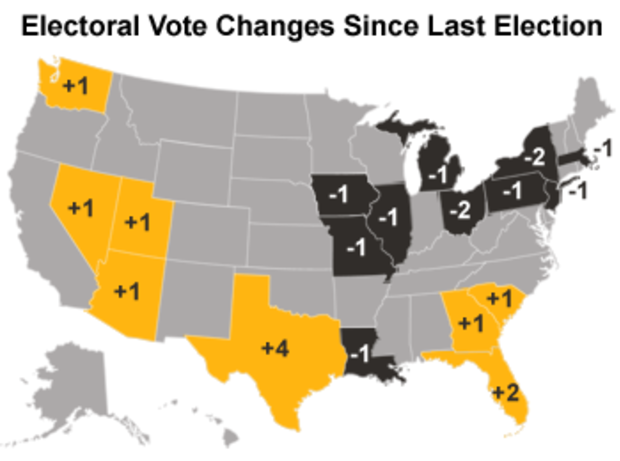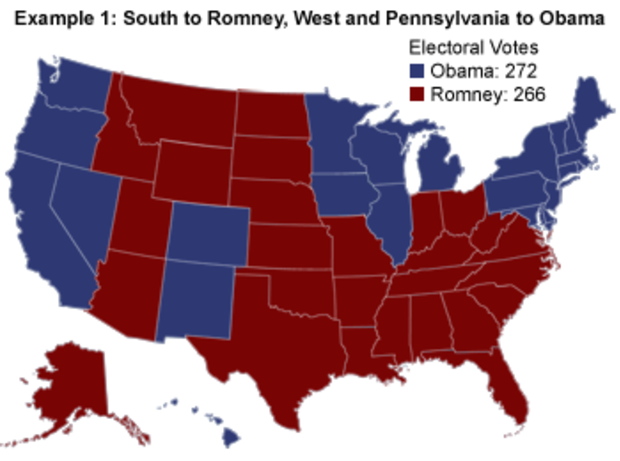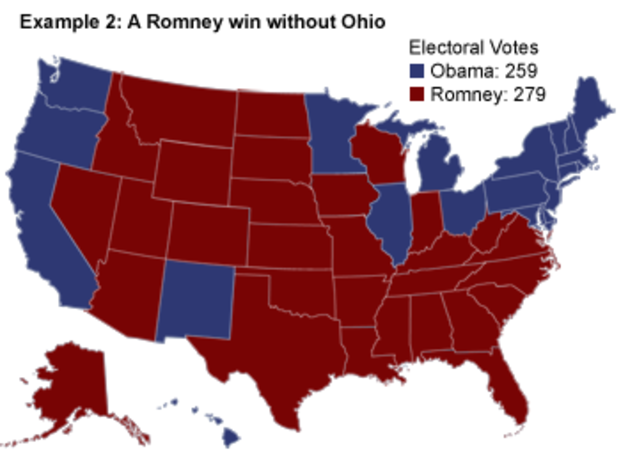The Electoral College map: How Obama or Romney could win
Recently we took a look inside the battleground states. Now that Mitt Romney has clinched the GOP nod, here's an early look at the whole map and some possible paths to 270 for him and Obama.
Though most of them are back in play, President Obama doesn't need to win all the states he carried four years ago to get to 270. So one could say he's got a cushion... or else that he's got a tough road ahead: Presidents who win second terms usually get more electoral votes in that re-election bid than they got on their first.* But what is clear is that the map offers multiple paths to victory for both Barack Obama and Mitt Romney.
There are votes in play in each region of the country with 135 electoral votes in the top battleground states as of now - plenty to swing the race either way. The CBS News Election Unit can estimate 191 electoral votes might go Republican and 212 may go Democratic as of now, from states that are leaning or likely for each camp based on voting history, polling and their demographics. (see the map above)
Note that electoral clout moved a bit south and west since the last presidential election, along with the Americans who moved to the Sunbelt in droves, and it's shifted slightly away from the Northeast and Midwest. As a baseline, that's a bit of a loss to the Democrats. It isn't big enough to be noticed in a blowout, but it could be important in a tight race, especially one that looks as tight as this one may be.
Reliably Democratic states New York (-2) New Jersey (-1) and Massachusetts (-1) all lost. The big prize of California didn't add any. Electoral vote gains in places like reliably-Republican Texas (+4, the single biggest winner) and South Carolina (+1) give a little help to the GOP baseline going in. (see map at left)
Meanwhile, the battlegrounds of Florida (+2) and Nevada (+1) gained, adding to their importance, and perennial battlegrounds like Ohio (-2) and Pennsylvania (-1) also lost clout since last time. Florida is now worth more than Virginia and North Carolina combined, or Wisconsin and Michigan together.
The South and West epitomized the changes Mr. Obama made to the electoral map last time, and they could be pivotal again. Back in 2008, he seized on changing demographics in faster-growing southern states, notably North Carolina, Virginia and to some extent Florida, helped by better showings with upper-income suburbanites (many of whom had recently located to these areas) along with strong support from large proportions of African American voters, and some better-than-expected showings with rural whites.
That coalition will be a challenge to repeat, especially the latter part of it. Simply as an electoral math exercise, imagine all three states go back to Romney, giving him 57 votes. That would put pressure on Mr. Obama to hold the western battlegrounds, at a minimum, and then do well in the Midwest too. Conversely, hanging on to even one of them would give Mr. Obama's chances a real boost.
The western battlegrounds of Nevada, Colorado and New Mexico have some similarities in their voting groups, too, most notably of course large numbers of Hispanic voters. To that point, New Mexico may be the most likely to stay blue if trends among Latino voters heavily favor Democrats by the fall. Although these three don't contain the electoral clout of those southern states - in fact, together not even as much as Florida - they do become important to Mr. Obama's math if he loses the whole south.
If those southern states go to Romney and Mr. Obama holds the West, Mr. Obama would probably need a very good Midwestern run of Wisconsin, Iowa, for example, and either Pennsylvania or Ohio to win. On the other hand, in that example, Romney would be close, and Iowa's six votes could flip it for Romney, as could New Hampshire's four.
In the Midwest, let's look at Ohio, specifically, for a moment. Historically, it has often been central to Republicans' chances at the White House, though a lot of that is from a time when the electoral map was more tilted east than it is today. Winning it would help Romney a lot, but there are scenarios in which he doesn't need it, if he breaks through and at least cherry-picks a few states across different regions.
For example: If Romney does well in the West - let's say, he wins Colorado and Nevada - and couples that with winning the South, including Florida, he'd be on his way. He could tack on Pennsylvania instead of Ohio and win the presidency or he could take Wisconsin and Iowa. Florida, perhaps even more so than Ohio, seems important to Romney's chances. Without it, he probably would need Ohio or wide success across the Midwest and the West, too.
A few quick last points:
There is no single state that starts off this race as clearly and solely determinative. And don't discount small states in a tight race. Even, perhaps, one of the single congressional district electoral votes allocated by Maine (which Romney may have a chance to get) or Nebraska (Mr. Obama won one of them last time.) And regional patterns could emerge as we move through the summer -- not only because of voting coalitions, but because of regional economic factors as well.
Remember, too, that early in presidential races campaigns usually try to define a map that's larger or more flexible then it will ultimately end up -- sometimes to force opponents to spend money defending territory, sometimes to rightly test the waters while there's still time and money. Michigan's 16 Electoral Votes lean Democratic at the start, given the demographic breakdown and vote patterns even if Mr. Obama falls off a bit from his 2008 levels, but a strong push from Romney would be worth watching. Arizona, with 11 Electoral Votes, is a state the Obama campaign had wanted to put in play last time and still reportedly has eyes on, but he'll need to move support even higher among Hispanic voters and reverse the falloffs he's seen among other groups to make that happen.
All told, the map is somewhat fluid, as we'd expect at this point. We need only look at 2008 when early on, it wasn't at all clear from the polls or the vote history that a Democrat could really win, for the first time in a long time, in places like Virginia or Indiana.
Note:
*Woodrow Wilson was the last to get fewer and win. This applies to second terms: FDR added in his second, but he then didn't match that for terms three and four. And the increase is not always dramatic; many come close to their firs total.




